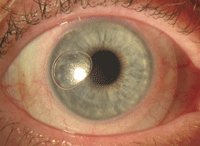 Q: I just started fitting scleral lenses recently and am having a difficult time minimizing bubbles under the lens. How can I be sure that they are resulting from the insertion technique—and how do I avoid them?
Q: I just started fitting scleral lenses recently and am having a difficult time minimizing bubbles under the lens. How can I be sure that they are resulting from the insertion technique—and how do I avoid them?
A: Air bubbles are a common challenge in scleral lens fitting. While small bubbles (2mm or less) may not interfere with the patient’s sight or eye health, large bubbles can disrupt the lens fit and negatively affect vision, in some cases leading to corneal desiccation. Air bubbles typically arise from improper application of the scleral lens or poor lens fit.
“If a bubble arises from improper application, it will be there immediately upon insertion,” says Jason Jedlicka, OD, who practices at the Cornea and Contact Lens Institute of Minnesota in Edina, Minn. “So, if you apply a lens and see the bubble the moment you look at the lens, it is usually from poor application.”
Scleral lenses function by holding a fluid reservoir, so when bubbles appear underneath the lens that means it’s losing fluid or didn’t get enough fluid during the application process.
The bottom line: Don’t skimp on the saline.
“Fill the lens completely to the rim with saline before application, and make sure the patient opens the eye sufficiently because solution will be lost if the lens bumps the lids during application,” says Greg DeNaeyer, OD, clinical director of Arena Eye Surgeons in Columbus, Ohio. “If the patient is having persistent difficulties, try having them fill the lens with Refresh Celluvisc (carboxymethylcellulose, Allergan) in place of saline. The carboxymethylcellulose is less likely to spill out because of its increased viscosity.”

A large air bubble under the scleral lens can disrupt lens fit and also negatively affect the patient’s vision and eye health. Photo: Greg DeNaeyer, OD
If you’re using plenty of fluid, your insertion technique could be the issue. “Practice will improve technique eventually,” Dr. Jedlicka says. “If the problem is the fitter during diagnostic fitting, make sure you use impeccable technique and have the patient help by holding the lower lid or standing up during application, as needed.”
If the bubble arises a few moments after application, you need to find a better fit. Usually, this means that the edge of the lens is loose in at least one area. “If your scleral lens has spherical peripheral curves, look for signs of scleral toricity. Perhaps a lens with a toric periphery would be in order,” Dr. Jedlicka says. “This would be apparent by checking all four quadrants of the lens fit and looking for tighter and looser sectors.”
In some instances, the sclera can be irregularly asymmetric, and even a toric periphery will not fix the issue. “In those cases, a quadrant-specific periphery, steepening the entire periphery or moving to a hybrid lens design may be needed to resolve bubble trouble,” he says.
Bubbles can also result from scleral lenses that have a fenestration—a small 1mm hole that is drilled into the paracentral region. Ordering the lens without a fenestration prevents this unwanted complication.

